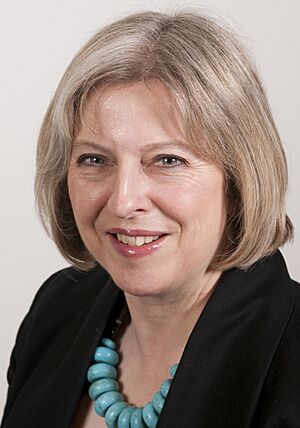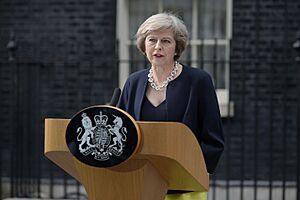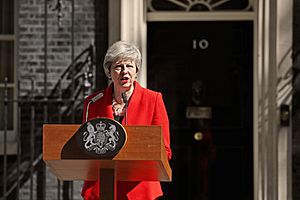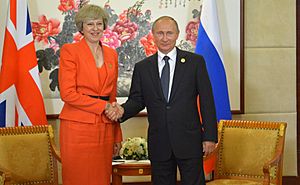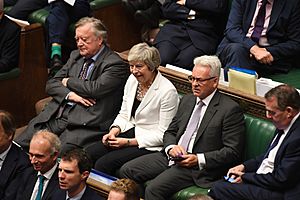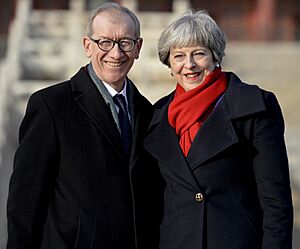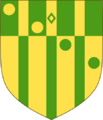Theresa May facts for kids
Quick facts for kids
The Baroness May of Maidenhead
|
|
|---|---|
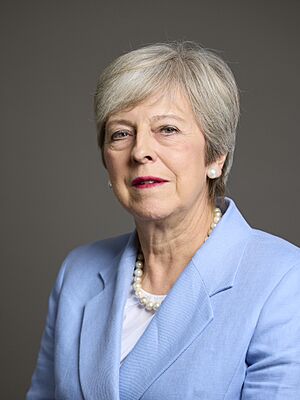
Official portrait, 2024
|
|
| Prime Minister of the United Kingdom | |
| In office 13 July 2016 – 24 July 2019 |
|
| Monarch | Elizabeth II |
| First Secretary | Damian Green (2017) |
| Preceded by | David Cameron |
| Succeeded by | Boris Johnson |
| Leader of the Conservative Party | |
| In office 11 July 2016 – 23 July 2019 |
|
| Preceded by | David Cameron |
| Succeeded by | Boris Johnson |
| Home Secretary | |
| In office 12 May 2010 – 13 July 2016 |
|
| Prime Minister | David Cameron |
| Preceded by | Alan Johnson |
| Succeeded by | Amber Rudd |
| Minister for Women and Equalities | |
| In office 12 May 2010 – 4 September 2012 |
|
| Prime Minister | David Cameron |
| Preceded by | Harriet Harman |
| Succeeded by | Maria Miller |
| Chair of the Conservative Party | |
| In office 23 July 2002 – 6 November 2003 |
|
| Leader | Iain Duncan Smith |
| Preceded by | David Davis |
| Succeeded by | |
|
|
| Assumed office 21 August 2024 |
|
| Member of Parliament for Maidenhead |
|
| In office 1 May 1997 – 30 May 2024 |
|
| Preceded by | Constituency established |
| Succeeded by | Joshua Reynolds |
| Shadow Cabinet portfolios | |
| 1999–2001 |
|
| 2001–2002 | Transport, Local Government and the Regions |
| 2003–2004 | Environment, Food and Rural Affairs |
| 2004–2005 | Family |
| 2005 | Culture, Media and Sport |
| 2005–2009 | Leader of the House of Commons |
| 2007–2010 | Women and Equality |
| 2009–2010 | Work and Pensions |
| Personal details | |
| Born |
Theresa Mary Brasier
1 October 1956 Eastbourne, England |
| Political party | Conservative |
| Spouse | |
| Relatives | Alistair Strathern (first cousin once removed) |
| Education | Wheatley Park School |
| Alma mater | St Hugh's College, Oxford (BA) |
| Signature | |
| n.b. | |
Theresa Mary, Lady May (born 1 October 1956) is a British politician. She was the Prime Minister of the United Kingdom and leader of the Conservative Party from 2016 to 2019. Before that, she was the Home Secretary from 2010 to 2016.
She was a Member of Parliament (MP) for Maidenhead from 1997 to 2024. Theresa May is the second woman to become UK prime minister, after Margaret Thatcher.
Contents
Early Life and Education
Theresa May was born on 1 October 1956 in Eastbourne, Sussex, England. She was the only child of Zaidee Mary and Hubert Brasier. Her father was a Church of England clergyman, which means he was a priest.
Her mother was a supporter of the Conservative Party. Sadly, her father died in 1981 from a car accident, and her mother passed away the next year from multiple sclerosis. May later said she wished her parents could have seen her become an MP.
Theresa May went to Heythrop Primary School, a state school. She then attended St. Juliana's Convent School for Girls, which was a private Roman Catholic school.
She studied geography at St Hugh's College at the University of Oxford. She graduated in 1977 with a degree.
Early Career in Politics
After finishing university in 1977, Theresa May worked at the Bank of England. She also worked for an organization that handles payments between banks.
She started her political career as a local councillor for Durnsford in Merton, London.
Becoming a Member of Parliament
Theresa May tried twice to become a Member of Parliament but wasn't successful. However, she was elected as the MP for the new area of Maidenhead in the 1997 general election.
From 1999 to 2010, she held various important roles in the shadow cabinets. This means she was part of the group of politicians who would take on government roles if their party won the election. She was also the Chair of the Conservative Party from 2002 to 2003.
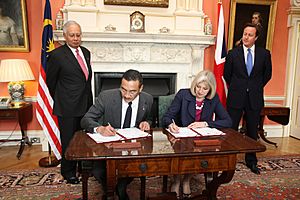
Her Time as Home Secretary
In 2010, Theresa May was given a very important job: Home Secretary. This role is in charge of policing, national security, and immigration in the UK.
During her time as Home Secretary, she worked to change the Police Federation. She also made new rules about who could come to live in the UK. For example, British citizens needed to earn a certain amount of money to bring their spouses or children to live with them.
She also led efforts to make internet and mobile service providers keep records of internet use, calls, and messages. This was so police could access them when investigating crimes.
For part of this time, from 2010 to 2012, she was also the Minister for Women and Equalities. This role focused on making sure everyone had fair opportunities.
Even though she supported staying in the European Union, she accepted the public's decision to leave after the 2016 referendum. She then supported Brexit.
She became prime minister without opposition after Andrea Leadsom left the leadership race.
Becoming Prime Minister (2016–2019)
On 13 July 2016, Theresa May was appointed Prime Minister by Queen Elizabeth II. She was the second woman to hold this top job in Britain. Standing outside 10 Downing Street, she said she was "honoured and humbled" to become prime minister.
As prime minister, her main task was to lead the UK's departure from the European Union, known as Brexit. She started talks with the EU to agree on how the UK would leave.
During her time as prime minister, there were also some difficult events. These included terrorist attacks in Westminster, Manchester, and London Bridge. There was also the tragic Grenfell Tower fire and the Windrush scandal.
Her government also announced a long-term plan for the National Health Service (NHS). She worked hard to get a deal for the UK's exit from the EU approved by Parliament.
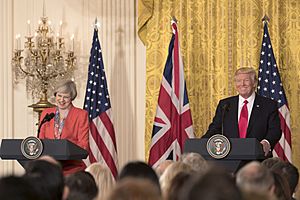
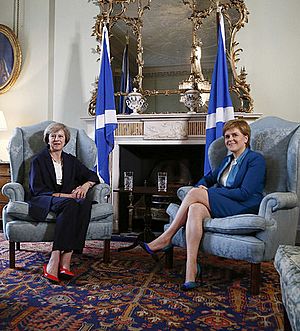
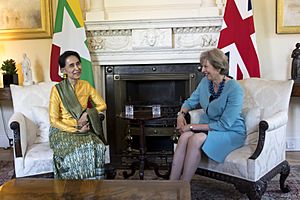
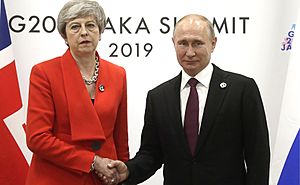
She faced two votes of no confidence in Parliament, but she survived them. However, her Brexit deal was rejected by Parliament three times. After her party did not perform well in the European Parliament election in May 2019, she decided to step down. She left office on 24 July 2019 and was replaced by Boris Johnson.
After Being Prime Minister (2019–present)
After leaving 10 Downing Street, Theresa May continued to serve as an MP. She was re-elected in the 2019 general election.
In March 2024, May announced that she would not stand for re-election as an MP. She was succeeded as MP for Maidenhead by Liberal Democrat Joshua Reynolds.
In August 2024, she was given a special honour called a life peerage. This means she became a member of the House of Lords, which is the second chamber of the UK Parliament. She is now known as Baroness May of Maidenhead.
Personal Life
Theresa May has been married to Sir Philip May since 6 September 1980. Philip works in investment management. It is said that former Prime Minister of Pakistan, Benazir Bhutto, introduced them when they were at Oxford University.
Theresa May has said she regrets that she and her husband did not have children. They live in the village of Sonning, which is in her former constituency.
She is a member of the Church of England and often goes to church. Her father was an Anglican priest, and she has said her Christian faith "is part of me."
In November 2012, Theresa May was diagnosed with Type 1 diabetes. She manages her condition with daily insulin injections.
Fun Facts About Theresa May
- She is the first woman to hold two of the "Great Offices of State" (Prime Minister and Home Secretary).
- When she was at college, she worked at a bakery on Saturdays to earn extra money.
- Theresa May is known for her love of fashion, especially her distinctive shoes.
- She and her husband enjoy hiking and often spend their holidays walking in the Swiss Alps.
- She is a big fan of cricket and considers Sir Geoffrey Boycott one of her sporting heroes.
- May enjoys cooking and has mentioned that she owns 100 cookery books!
Famous Quotes
- "If you believe you are a citizen of the world, you’re a citizen of nowhere."
- "In tough times, everyone has to take their share of the pain."
- "Like Indiana Jones, I don't like snakes - though that might lead some to ask why I'm in politics."
- "Brexit means Brexit."
- "My whole philosophy is about doing, not talking."
- "Politics is about public service."
Images for kids
See also
 In Spanish: Theresa May para niños
In Spanish: Theresa May para niños


